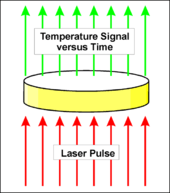Laser flash analysis
|
| |
| Uses | to measure thermal diffusivity, thermal conductivity, specific heat, |
|---|---|
The laser flash analysis or laser flash method is used to measure thermal diffusivity of a multiplicity of different materials. An energy pulse heats one side of a plane-parallel sample. The temperature rise on the backside due to the energy input is time-dependent detected. The higher the thermal diffusivity of the sample, the faster the energy reaches the backside. A state-of-the-art laser flash apparatus (LFA) to measure thermal diffusivity over a broad temperature range, is shown on the right hand side.
In a one-dimensional, adiabatic case the thermal diffusivity is calculated from this temperature rise as follows:
Where
- is the thermal diffusivity
- is the thickness of the sample
- is the time to the half maximum
Measurement principle

The laser flash method was developed by Parker et al. in 1961.[1] In a vertical setup a light source (e.g. laser, flashlamp) heats the sample from the bottom side and a detector on top detects the time-dependent temperature rise. For measuring the thermal diffusivity, which is strongly temperature-dependent, at different temperatures the sample can be placed in a furnace at constant temperature.
Perfect conditions are
- homogenous material,
- a homogenous energy input on the front side
- a time-dependent short pulse - in form of a Dirac delta function
Several improvements on the models have been made. In 1963 Cowan takes radiation and convection on the surface into account.[2] Cape and Lehman consider transient heat transfer, finite pulse effects and also heat losses in the same year.[3] Blumm and Opfermann improved the Cape-Lehman-Model with high order solutions of radial transient heat transfer and facial heat loss, non-linear regression routine in case of high heat losses and an advanced, patented pulse length correction.[4][5]
See also
References
- ↑ W.J. Parker; R.J. Jenkins; C.P. Butler; G.L. Abbott (1961). "Method of Determining Thermal Diffusivity, Heat Capacity and Thermal Conductivity". Journal of Applied Physics. 32 (9): 1679. Bibcode:1961JAP....32.1679P. doi:10.1063/1.1728417.
- ↑ R.D. Cowan (1963). "Pulse Method of Measuring Thermal Diffusivity at High Temperatures". Journal of Applied Physics. 34 (4): 926. Bibcode:1963JAP....34..926C. doi:10.1063/1.1729564.
- ↑ J.A. Cape; G.W. Lehman (1963). "Temperature and Finite-Pulse-Time Effects in the Flash Method for Measuring Thermal Diffusivity". Journal of Applied Physics. 34 (7): 1909. Bibcode:1963JAP....34.1909C. doi:10.1063/1.1729711.
- ↑ U.S. Patent 7,038,209
- ↑ J. Blumm; J. Opfermann (2002). "Improvement of the mathematical modeling of flash measurements". High Temperatures – High Pressures. 34: 515. doi:10.1068/htjr061.